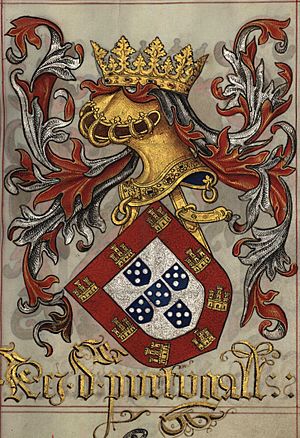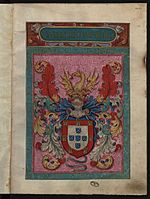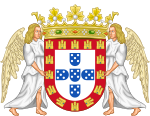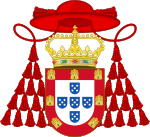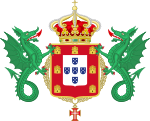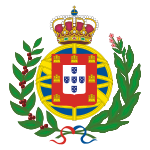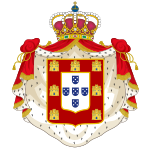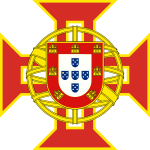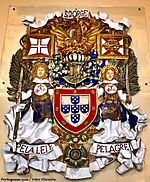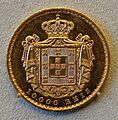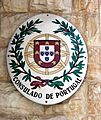Coat of arms of Portugal facts for kids
Quick facts for kids Coat of arms of Portugal |
|
|---|---|
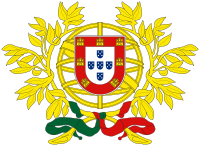 |
|
| Versions | |

Version without laurel branches, for use on the national flag, naval jack and some governmental flags
|
|
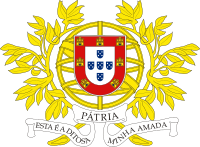
Version with the motto, for use on the national colors of the military units
|
|
| Armiger | Portuguese Republic |
| Adopted | 30 June 1911 |
| Blazon | Argent, five escutcheons in cross azure each charged with as many plates in saltire, all within a bordure gules charged with seven golden triple-towered castles |
| Motto | Esta é a ditosa Pátria minha amada ("This is my blissful beloved homeland") |
| Other elements | Behind the shield, an armillary sphere between two laurel branches embowed Or bound together in base by a ribbon vert and gules. |
The coat of arms of Portugal is a very important symbol for the country. It's like a special badge that represents Portugal. The design we see today was officially chosen on June 30, 1911. It was adopted at the same time as the current Flag of Portugal. This coat of arms is based on older designs used by the Portuguese Kingdom for many centuries. People often call the coat of arms the Quinas. A quina means a group of five things.
Contents
What does the current coat of arms look like?
The current design of Portugal's coat of arms was created by a painter named Columbano. He was part of a group chosen in 1910 to design a new national flag. This happened after Portugal became a republic on October 5, 1910. The designs were approved in November 1910 and made official in June 1911.
There are three main versions of the coat of arms. Each one is used for different purposes. All three versions have the traditional Portuguese shield placed over a golden armillary sphere.
What is the basic version of the coat of arms?
The basic version has only the Portuguese shield over the armillary sphere. This simple version is used on the National Flag and on naval flags. It is also used on flags for the President and other government officials. Sometimes, people unofficially call this the "lesser arms of Portugal."
What is the military version?
The second version includes the shield and armillary sphere. It also has two laurel branches around them. These branches are tied at the bottom with a white ribbon. On the ribbon, there's a famous line from the poet Camões: Esta é a ditosa Pátria minha amada. This means "This is my beloved merry homeland." This version is used on the flags of military units.
What is the official seal version?
The third version is similar to the military one. However, the ribbon does not have the verse. It is usually shown in red and green colors. This version is used on official seals, coins, and other national symbols.
What are the main parts of the coat of arms?
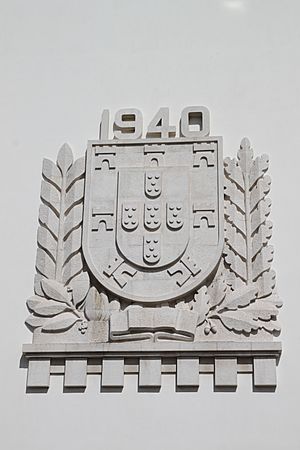
The Portuguese coat of arms has several important parts. Each part tells a story about Portugal's history.
What are the Quinas?
Quina is a Portuguese word for a group of five. After Portugal became an independent country in 1143, silver circles were added to the blue cross on the shield. These circles looked like coins. They showed that the king had the right to make his own money. This was a sign that Portugal was a sovereign country.
Over time, the shield changed. The cross eventually became five blue shields, each with five silver circles. A popular story says these five shields represent five Moorish kings. King Afonso I of Portugal supposedly defeated these kings in the Battle of Ourique.
The number of silver circles on each small shield used to change. But by the late 1300s, it was set at five. Some people later said these five circles represent the five wounds of Jesus Christ. The groups of five shields, each with five circles, became known as quinas. Today, "Quinas" is often used to refer to the entire coat of arms. It can even mean anything that represents Portugal.
What do the castles mean?
During the reign of King Afonso III of Portugal, a red border with golden castles was added to the shield. The number of castles varied at first. But King Sebastian I finally set the number at seven. These castles are believed to represent the Moorish castles that Portugal conquered during the Reconquista. This was a long period when Christian kingdoms took back land from the Moors.
The castles might also come from the coat of arms of Afonso III's mother, Urraca of Castile. Unlike Spanish castles, Portuguese castles are usually shown with closed gates. This means they are gold.
What is the armillary sphere?
The armillary sphere has been an important part of Portuguese symbols since the 1400s. It was often used on Portuguese naval and colonial flags, especially in Brazil. An armillary sphere was a tool used by sailors to calculate distances. It represents Portugal's important role during the Age of Discovery. It also shows how vast Portugal's empire was when the First Republic began.
The armillary sphere was a personal symbol of King Manuel I. It was first added to the national flag in 1815. This was when Portugal, Brazil, and the Algarves formed a united kingdom. The group that designed the current flag in 1910 suggested the armillary sphere. They called it "the eternal standard of our adventurous spirit."
What are the laurel branches?
The original republican design from 1910 included two laurel branches. They form a wreath around the shield and armillary sphere. Laurel branches often symbolize victory and honor.
How did the coat of arms change over time?
The national symbols of Portugal grew from the symbols used by its kings. The royal coat of arms slowly became the national coat of arms. It has changed a lot over nearly a thousand years. It started with a blue cross on a white shield in the 1100s. New parts were added or removed, leading to the design we see today. This design was officially adopted in 1911.
How did the shield evolve?
The main part of the coat of arms has always been the Portuguese shield. It took about 300 years to reach its final form.
The first king of Portugal, Afonso Henriques, used a shield with a blue cross on a white background. This was probably the same as his father's shield.
Later, the shield changed to five blue shields in a cross shape. Each small shield had many silver circles. This is the first confirmed design of the Portuguese shield. It was used during the time of Afonso Henriques and his son, King Sancho I of Portugal.
What are the legends about the small shields?
There are many stories about the five small shields and the silver circles. Some say the shields represent the Five Holy Wounds of Christ. Others say they are the five wounds Afonso Henriques got in the Battle of Ourique. Or, they could be the five Moorish kings he defeated.
The silver circles might represent the thirty pieces of silver Judas received for betraying Jesus. Or, they could show the king's right to make his own money. A simpler idea is that the shield was just a battle shield. It might have had blue leather bands nailed to a white base. After many battles, only five pieces of blue leather with bright nail heads were left. These pieces became the five blue shields with silver circles.
Why was a border added?
When Afonso III of Portugal became king, he added a red border with golden castles to the shield. He kept this design even after he became king. Many theories explain the castles. The most popular one says they represent the last castles taken from the Moors in the Algarve.
However, the most accepted idea is that the border was a way to show that Afonso was not the first son. The castles likely came from the coat of arms of his mother, Urraca of Castile. Later, the number of castles was set at seven. This is the version still used today.
What about the Cross of Aviz?
During a time when Portugal had no clear king (1383-1385), John, the master of the Order of Aviz, became a candidate for the throne. When he became King John I, the symbol of his order was added to the royal shield. This was a green cross with a fleur-de-lys at the end of each arm. It was sometimes placed inside the border or even outside the shield.
Why were the small shields made upright?
In 1485, King John II of Portugal ordered changes to the shield. He removed the Cross of the Order of Aviz. He also made the side shields stand upright. This was to avoid any idea that they symbolized something negative. The number of silver circles on each of the five shields was fixed at five. They were arranged in a cross shape. This was a reference to the Five Holy Wounds of Christ, which was important to the king. This arrangement of five shields, each with five circles, became known as quinas.
What other elements surrounded the shield?
Until the early 1300s, the Portuguese coat of arms was just the shield. No other elements were around it.
A crown started appearing above the shield in the 1300s. At first, it was a simple open crown. Later, it became a more complex crown with leaves. From the 1500s until 1910, the royal crown was almost always part of the coat of arms. It was the only constant element around the shield. King Sebastian changed the open crown to a closed one with a single arch. Later, it had two arches. The final crown design was adopted in the late 1600s. It had four arches and a globe with a cross on top.
Other elements also appeared around the shield, but they were not always there like the crown.
One important element was the crest. From the reign of John I, this crest was a dragon. This was probably linked to Saint George becoming Portugal's patron saint. The dragon was first gold, then green from the 1600s. This change might be because the House of Braganza became kings in 1640. Green was their color and became a national color. During their rule, two green dragons often supported the royal shield.
A golden helmet was also often shown between the 1300s and 1500s. It rarely appeared after that.
Supporters are figures that hold up the shield. Angels were often used as supporters until the 1700s. Sometimes, a single angel supported the shield. This angel might have been the Guardian Angel of Portugal. From King Manuel I's time, angels often held armillary spheres or crosses of the Order of Christ. From the 1700s, the green dragons that were once crests also became common supporters.
King Manuel I's personal symbols, the armillary sphere and the cross of the Order of Christ, became very popular. They were used so much that they became national symbols. They continued to be used even after his reign. Sometimes, the armillary sphere even supported the shield. This was similar to how it would be used centuries later in the arms of the United Kingdom of Portugal, Brazil and the Algarves, and the Portuguese Republic.
From the mid-1800s, the royal coat of arms was often shown with the shield covered by a pavilion. This was a purple cloth lined with ermine fur, coming from the royal crown.
| Historical supporters and other external elements adorning the Portuguese coat of arms | |||||||
|---|---|---|---|---|---|---|---|
| Dragon or crest, helmet or and mantling gules, or, azur and argent in a Thesouro da Nobreza armorial representation of the Portuguese achievement of arms | Angels as supporters of the 15th century shield (House of Aviz) | Cardinal hat on the top of the Portuguese arms used in the reign of King Henry | Green wyverns as supporters of an 18th century model shield (House of Braganza) | The armillary sphere as supporter of the Portuguese shield in the Coat of arms of the United Kingdom of Portugal, Brazil and the Algarves | Pavilion in a 19th century model coat of arms | Cross of the Order of Christ as the supporter of the Portuguese arms in the badge of the Order of the Colonial Empire | Supporters wearing a tabard bearing the badge of the Sash of the Three Orders and holding a banner of the cross of the Order of Christ and the standard of King Manuel I in a 20th century model coat of arms (Estado Novo) |
Images for kids
-
Relief achievement of arms of the House of Habsburg at the El Escorial, Spain, with the Portuguese shield in the honour point
-
Baroque coat of arms on the portal of the Misericórdia Church of Braga
-
(On the left) Portuguese coat of arms over the cross of the Order of Christ in the Cape Verde 2.5 escudos coin of 1967
-
Coat of arms in the plaque of the Portuguese consulate at Haifa
-
Relief achievement of arms of Two Sicilies in the Teatro di San Carlo, with the Portuguese shield depicted in sinister side
-
Royalist style Portuguese coat of arms on a column at Julio Bras Portuguese Park in Hayward, California
See also
 In Spanish: Escudo de Portugal para niños
In Spanish: Escudo de Portugal para niños


